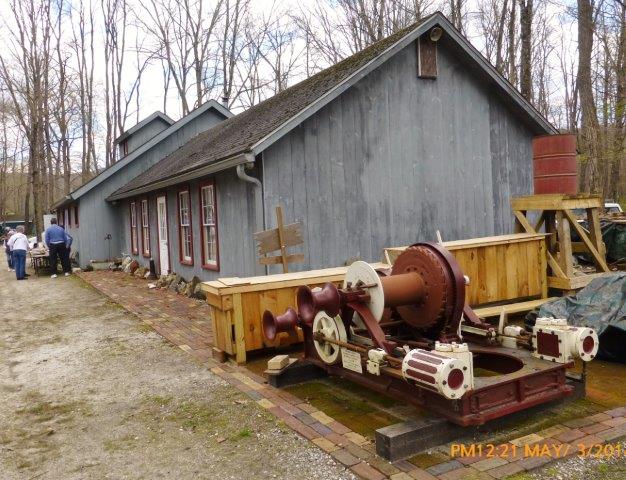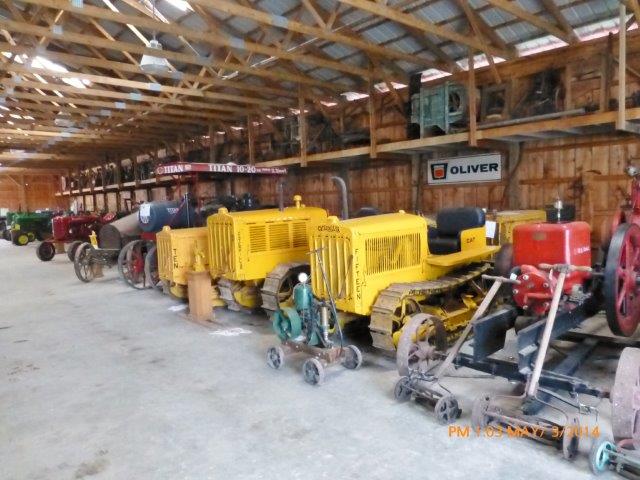
July 2014
A Connecticut Visit
By Paul Harvey
Sometimes it is just good to get away. The winter had
been long and hard and the museum's June engine show seemed to be
approaching all too quickly. That meant six weeks of panic,
preparation, and hard work. So I did the reasonable thing and invited a
friend to join me for a weekend of relaxation at the
Leaving early Friday morning, we made many stops and side trips as we
enjoyed the warm spring weather.
Next morning, we passed through the quaint
Passing through the flea market, I headed for Industrial Hall,
Photo 4, where several
large stationary steam engines operate. Upon entering, I was greeted
with the aroma of hot steam and oil and the music of an engine in
operation. The Greene Steam Engine, Photo 5,
built in
I next wandered toward the river and found the oil field rod line
pumping power exhibit with several operating jacks along the bank of the
Photo 11 shows the oil field engine building containing
six nicely restored engines. It is also backed by the river and a
forested hillside beyond which seemed so appropriate. A 15 hp Pattin
brothers, built in
Walking back from the oil field display, I came upon the blacksmith shop. Photo 13 depicts the building with both an outside and inside forge so that two smithies can display their arts simultaneously. The inside forge, in operation as seen in Photo 14, shows the blacksmith attending his fire. He uses coal and an air blast to turn the iron white hot. Then it can be forged into many shapes on the anvil. The shop is complete with all appropriate tools and a line shaft operating the blower and other items. I was amazed at the mirror-like polished face of his anvil which he kept wiped clean with oil after each use.
Next, Photo 15 is the big gas engine building which
certainly appears to be an industrial powerhouse. It contains many large
and interesting engines far beyond the scope of this writing. But just
inside that open door, one is greeted by a big
Photo 18 shows the Mining and
The day was quickly passing, as I realized that I was hungry. Finding the food pavilion, Photo 19, I was soon satisfied with two hot dogs, a big bowl of chili, and a Coke. While resting, I realized what a diversity of displays I had seen in a few short hours! But now I was ready to continue onward.
I then strolled to the Diebold Agricultural Hall, Photo 20, which is on the edge of the wooded area and borders a vast display field. This structure houses tractors and all sorts of mobile mechanical equipment. Photo 21 shows part of one row of tractors featuring some very early Caterpillars. Long before Caterpillar was used for construction, the durable little crawlers were popular for farming in wet areas. There were many steam traction engines and construction equipment such as road rollers and maintenance machines. Larger machines, notably cable shovels and backhoes, are displayed outside.
Probably the most unique display is the
With the day drawing to a close, I walked out through the display area and was fascinated with this woodsplitter belted to a Sattley engine as seen in Photo 24. The newest building, the sawmill, is seen in the background of this photo. The organization has a great display as well as a source of needed lumber. Slowly I ambled back toward the main part of the grounds to bid farewell to my friends there. Reflecting on the great day, I was overwhelmed with the diversity of knowledge that is here in one small area. It's "a little bit of everything!"
By the time you are reading this, it is July and

Photo 1: CAMA logo

Photo 2: 1925 Baldwin steam locomotive

Photo 3: Welcome Center

Photo 4: Industrial Hall

Photo 5: Greene steam engine

Photo 6: Greene valve mechanism

Photo 7: Brown steam engine

Photo 8: Nagle Corliss steam engine

Photo 9: Oil field rod line and pump jack exhibit

Photo 10: A.C. Thomas engine

Photo 11: Oil field engine building

Photo 12: 15 hp Pattin Brothers engine

Photo 13: The blacksmith shop

Photo 14: A blacksmith at work

Photo 15: The gas engine building

Photo 16: Clark engine

Photo 17: Buffalo engine

Photo 18: Mining and Mineral Building

Photo 19: Lunchtime at the food pavilion

Photo 20: Diebold Agricultural Hall

Photo 21: Just a portion of the tractor display

Photo 22: Cream Hill Agricultural School

Photo 23: Dr. Gold's desk and study

Photo 24: Woodsplitter, Sattley engine, and sawmill